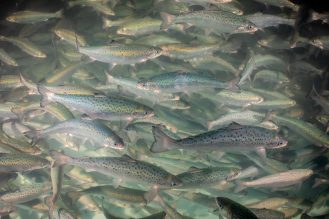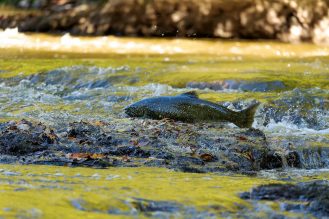Just Keep Swimming, Swimming, Swimming… Watch the Salmon Run this Fall
Environment | September 29, 2022
Want a front row seat to one of nature’s most amazing feats? Each fall the annual salmon migration – or salmon run – happens right here in Mississauga. As water temperatures start to cool, freshwater salmon begin their yearly trek from Lake Ontario up the Credit River to spawn.
Here are a few tips to help you enjoy the salmon run this fall.
- Know Where to Go
There are several great locations in Mississauga to check out this annual phenomenon.
-
- Erindale Park: The City’s largest park offers extensive trails through ravines and open spaces giving you lots of chances to get up close to the Credit River.
- Meadowvale Conservation Area: Located in the north part of the City, this natural oasis gives you a good opportunity to watch the migration from a pedestrian bridge overlooking the Credit River.
- Riverwood: This 150-acre park and urban oasis includes accessible trails and great views. The Credit River flows through the park’s western border offering excellent spots to watch the salmon run.
- Brush Up on Your Salmon 101
Each year, salmon in Lake Ontario return to the streams where they were born (or stocked) to reproduce. Three types of salmon make their way to the Credit River in the fall:
-
- Chinook salmon: This species migrate once they reach maturity (between three and seven years) and typically die after spawning is complete. Chinook can grow up to 100 centimetres in length.
- Atlantic salmon: Unlike Chinook salmon, this smaller salmon species make their way back to Lake Ontario after their migration upstream. Atlantic salmon are native to Lake Ontario.
- Coho salmon: While smaller than the Chinook, both species are native to the north Pacific Ocean and were introduced to the Great Lakes in the 1960s. Coho can grow up to 75 centimetres in length.
In the spring, offspring from all three species hatch and swim downstream. They make their home in Lake Ontario until it’s their time to migrate.
- Don’t Miss It!
Get ready! Salmon migration season is now underway. It peaks in early October and most fish have spawned by the end of the month.
When you’re out and about, give salmon the best chance of survival by respecting their space. That includes steering clear of areas where salmon are swimming and along the riverbed where they lay and fertilize their eggs. Make sure you are also aware of all recreational fishing rules and regulations that apply for the Credit River (Fisheries Management Zone 16) during this important migration season.
Watch videos of salmon in the Credit River or learn more about the Credit River Watershed by visiting the Credit Valley Conservation website at cvc.ca.
Tags
Media contact
City of Mississauga Media Relations
media@mississauga.ca
905-615-3200, ext. 5232
TTY: 905-896-5151


